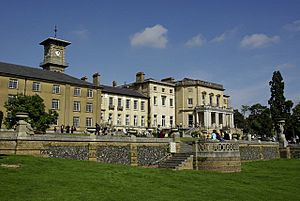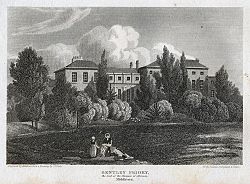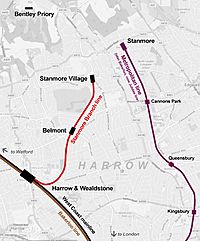Bentley Priory facts for kids
Bentley Priory is a grand old house and deer park located in Stanmore, on the northern edge of London. It has a long and interesting history, from its medieval beginnings as a religious house to becoming a headquarters during World War II. Today, parts of it are luxury homes, but it also hosts an important museum and a beautiful nature reserve.
Quick facts for kids Bentley Priory |
|
|---|---|

The priory in 2008
|
|
| Type | Stately home |
| Location | Harrow |
| OS grid reference | TQ 15473 93279 |
| Area | London |
| Built | 1789–1818 |
| Architect |
|
|
Listed Building – Grade II*
|
|
| Official name: Central entrance block of Bentley Priory | |
| Designated | 25 May 1983 |
| Reference no. | 1358638 |
| Official name: Bentley Priory | |
| Designated | 9 December 1999 |
| Reference no. | 1001440 |
| Lua error in Module:Location_map at line 420: attempt to index field 'wikibase' (a nil value). | |
Bentley Priory was once a medieval priory, which is a type of monastery. It was home to Augustinian Canons, a group of religious men. Although no parts of the original priory remain, it was likely located near Priory House on Clamp Hill.
In 1775, a famous architect named Sir John Soane designed a large mansion called Bentley Priory. It was built for a rich businessman, James Duberley. Over the years, different owners added to the house. It became the final home of Dowager Queen Adelaide, the wife of King William IV, before she passed away in 1849. Later, it was a hotel and a girls' school.
In 1926, the Royal Air Force (RAF) bought the priory. During the Second World War, Bentley Priory became the very important headquarters of RAF Fighter Command. It stayed with the RAF until 2008.
Today, some of the building has been turned into fancy apartments. However, the Bentley Priory Battle of Britain Trust saved a part of the building. This part is now a museum and a memorial. It honors those who served in the RAF, especially during the Battle of Britain.
Contents
The Priory's Ancient Past
Even before the Romans, people lived in the area around Bentley Priory. Roman remains have been found in the grounds, showing its long history.
Medieval Beginnings
The name Bentley comes from old Anglo-Saxon words. "Bent" means a type of coarse grass, and "ley" means land cleared for pasture or farming. So, Bentley likely means land cleared of tough grass for animals or crops.
The first priory was a small monastery for Augustinian Friars. It was dedicated to St. Mary Magdalene. Some records suggest it was founded in 1171 by Ranulf de Glanvill, a powerful official for King Henry II.
The priory was under the control of St Gregory's Priory, Canterbury. In the 1300s, there were mentions of the priory and its activities. However, by 1535, St Gregory's had stopped using Bentley as a cell.
One old story from 1248 tells of the "Miserable Death of the Priory of Bentley." Apparently, a hayrick fell on him while he was checking it!
After the monasteries were dissolved in 1536, the land changed hands many times. It went from the church to various wealthy owners.
Building a Grand House
In 1775, Sir John Soane designed a new, grander house called Bentley Priory. It was built on a higher spot than the original priory. James Duberley, a rich army contractor, owned it first.
In 1788, John Hamilton, 1st Marquess of Abercorn, bought the house. He hired Sir John Soane again to make it even more luxurious. The outside of the house you see today largely comes from his vision. He added a gallery for paintings, large rooms, and a grand staircase.
Many famous people visited the Marquess at Bentley Priory. These included important politicians like Wellington and poets like Walter Scott. Sir Walter Scott often stayed in a summerhouse on an island in the lake. He wrote parts of his famous poem, Marmion, there in 1807. The lake is still part of the Bentley Priory Nature Reserve today.
The second Marquess of Abercorn also lived at the Priory. However, he found that too many friends visited and stayed too long! He eventually moved his family away from the house.
Queen Adelaide's Final Home
In 1846, Dowager Queen Adelaide leased Bentley Priory. She was the widow of King William IV. She moved in during 1848, but she was quite ill. Special rooms were made for her on the ground floor. Her niece, Queen Victoria, and Prince Albert visited her there.
Queen Adelaide passed away at Bentley Priory on December 2, 1849, at the age of 57.
After her death, Sir John Kelk bought the estate in 1863. He was a famous engineer who built the Albert Memorial. Sir John made many improvements to the Priory. He added a picture gallery, a library, and a clock tower. He also created a cedar garden and a deer park.
The Hotel Years
In 1882, Frederick Gordon, who owned many hotels, bought Bentley Priory. He turned it into a fancy residential hotel. To make it easier for guests to reach the hotel from London, Gordon even extended the railway line. He built the Stanmore branch line just for this purpose.
Despite the railway, the hotel was not a big financial success. The Gordon family eventually moved into the Priory themselves.
School Days
After Frederick Gordon's death in 1908, Bentley Priory became a girls' school. It housed about 70 boarding students. The school focused on music and had many pianos in soundproof rooms. The school did well for several years. However, after World War I, it faced money problems. The school closed its gates for good on December 28, 1924.
Bentley Priory and the RAF
In 1926, the Air Ministry bought Bentley Priory. It became a training command center for the RAF. Its most famous role came during the Second World War. Bentley Priory served as the headquarters for RAF Fighter Command. This made it a very important place in history, especially during the Battle of Britain.
The commander of RAF Fighter Command during the Battle of Britain was Sir Hugh Dowding. He was honored with a special title, Baron Dowding of Bentley Priory, in 1943. After the war, the site continued to be used by the RAF for various administrative tasks. It finally closed on May 30, 2008.
Bentley Priory Today
In 2011, developers bought the estate and house. They planned to turn it into luxury homes.
However, in 2013, an effort began to create a museum in the priory house. This museum would remember its vital role in the Battle of Britain. Charles III, who was then Prince of Wales, officially opened the Bentley Priory Museum in September 2013. It opened to the public in January 2014. The museum is managed by The Bentley Priory Battle of Britain Trust.
The beautiful grounds around the priory are now the Bentley Priory Nature Reserve. This area is a Site of Special Scientific Interest, meaning it's important for its wildlife and natural features.
See also





